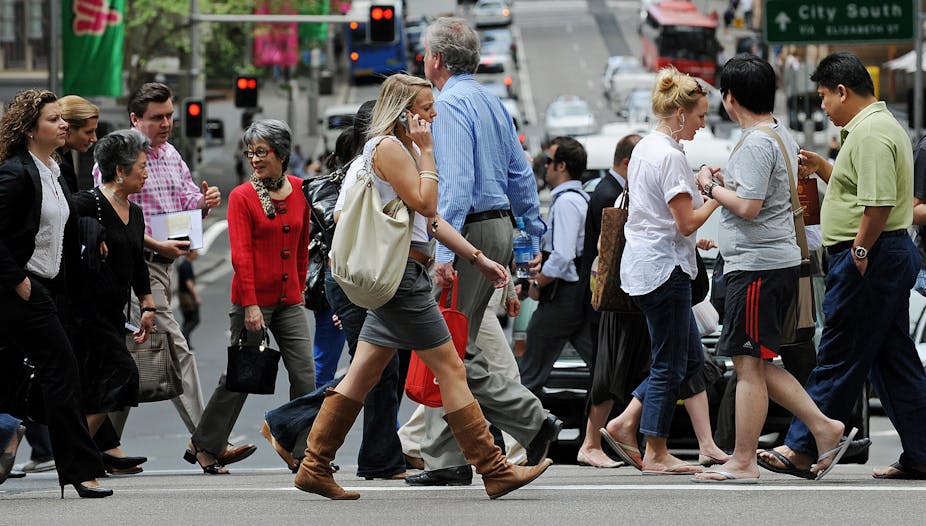Carbon tax or not, Australia’s emissions will keep rising, driven by rapid rates of population growth and increasing affluence. Most of the carbon is domestic but we also own the carbon that China and other manufacturers emit when they make stuff we purchase from our malls and big box stores.
The “Bigger Australia” much loved by Kevin Rudd and the top end of town surfaced again in the last federal election when both major parties scrambled for a “right-sized Australia”. The debate was driven by disenchantment in marginal electorates where services are tight and solutions often promised.
Unseen in the election dog-whistling was a science-based population futures report, Long-term physical implications of net overseas migration: Australia in 2050.
It highlighted the many resource and environmental challenges that come with rapid rates of population growth, in the absence of revolutionary changes, in how Australia conducts its business of day-to-day living.
By 2050, these challenges include between a doubling and a tripling of greenhouse emissions, a looming oil dependence, increased traffic congestion and critical water shortages in three capital cities.
This is bad news for the legion corporate suits who see rapid population growth as the only way to maintain their cash flow in an economy based on house building, personal consumption and mining.
The news was so bad that the Department of Immigration and Citizenship (DIAC) chose Christmas Eve of 2010 to release the report with a frontispiece demeaning the science-based modelling as contested, and not to be believed.
As judged by a lone economics reviewer, the physical-economy analysis did not conform to the assertions and beliefs of an economics-centric world.
However the three components of the study, while strongly related, were independently sourced thus ensuring greater robustness than if they relied on a single analytical idea.
The middle tier or regional scale of analysis in particular gives the key insights for national population policy and the consequences of a bigger Australia.
As most inbound migrants ended up in discrete areas of Sydney, Melbourne and Perth, the report found that if things were already partially crook in those areas, it could only get crooker under the rapid population growth that a bigger Australia requires to gather steam.
As most Sydneysiders know, the geography that gives its beauty and attractiveness is also a beast when several million more people have to be settled by 2050.
Unless the multi-billions that are promised at each election time are spent quickly, and over and over, the city function and economic product will stall in a gridlock of disgruntled ratepayers in the far-flung suburbs.
In western Sydney where most population growth occurs, water and soil quality and biodiversity resources can only trend downwards given the experience over the last twenty years of development.
As cost and time over-runs on its Wonthaggi desalinisation plant dominate the media headlines for Melbournians, they might ponder how many more engineering projects they’ll have to pay for with another two million people.
The green wedges, meant to buffer biodiversity losses in the face of development, have been discarded by an incoming government intent on bettering the previous bunch.
Still Melbourne has easier topography and better public transit that its arch-rival Sydney and with strong ongoing investment, might just retain its liveable city status.
Perth’s long-term future is here now. As its second desalination plant nears completion, its surface dams receive trickles rather than floods, and its groundwater aquifers approach their extraction limits.
The region’s sandy soils transmit sewage and farming nutrients easily and which can increase algae in rivers and estuaries.
Set in one of the world’s biodiversity hotspots, rapid increases in land clearance to indulge the suburban dream will pressure nature’s diversity even more than in the recent past.
But this future is not hardwired, provided public policy is built on three cores.
The first is to stabilise national population to a 26-28 million level by 2050.
The second is to be as mean as possible to each Australian by introducing an integrated carbon-water-land taxation base. The new system would penalise profligate use of critical resources and provide the funds to refurbish and make anew.
The third is to do what we must do and quickly. Ten star houses, nearly independent of power and water grids, are here now.
All cities need fluent transport in an oil-lean future, so why not rapid transit for all now?
Our households are bulging with stuff we don’t need and don’t want, our bodies also.
So why not a lifestyle where enough is enough, rather than more being our common mantra?
Today’s population policy is driven by the Dolly Parton syndrome, where bigger is better even if it is top heavy and somewhat false.
Using science to explore Australia’s future gives the view that we’d probably be better off, leaner and smaller.
However if Australians want the quality of life we now enjoy, then the challenges are already daunting and we’d better start the grand transition today.

